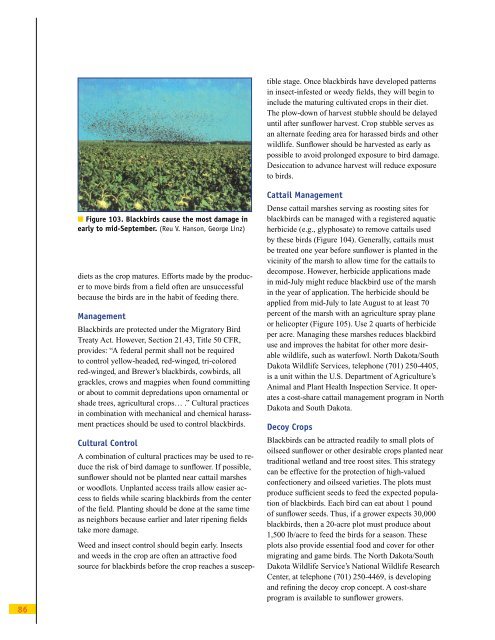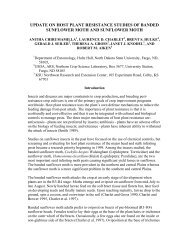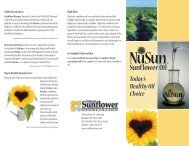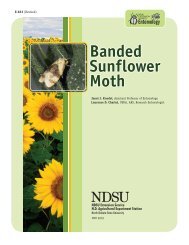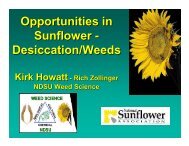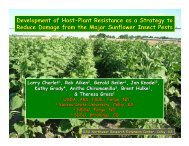Sunflower Production - NDSU Agriculture - North Dakota State ...
Sunflower Production - NDSU Agriculture - North Dakota State ...
Sunflower Production - NDSU Agriculture - North Dakota State ...
You also want an ePaper? Increase the reach of your titles
YUMPU automatically turns print PDFs into web optimized ePapers that Google loves.
86■ Figure 103. Blackbirds cause the most damage inearly to mid-September. (Reu V. Hanson, George Linz)diets as the crop matures. Efforts made by the producerto move birds from a field often are unsuccessfulbecause the birds are in the habit of feeding there.ManagementBlackbirds are protected under the Migratory BirdTreaty Act. However, Section 21.43, Title 50 CFR,provides: “A federal permit shall not be requiredto control yellow-headed, red-winged, tri-coloredred-winged, and Brewer’s blackbirds, cowbirds, allgrackles, crows and magpies when found committingor about to commit depredations upon ornamental orshade trees, agricultural crops… .” Cultural practicesin combination with mechanical and chemical harassmentpractices should be used to control blackbirds.Cultural ControlA combination of cultural practices may be used to reducethe risk of bird damage to sunflower. If possible,sunflower should not be planted near cattail marshesor woodlots. Unplanted access trails allow easier accessto fields while scaring blackbirds from the centerof the field. Planting should be done at the same timeas neighbors because earlier and later ripening fieldstake more damage.Weed and insect control should begin early. Insectsand weeds in the crop are often an attractive foodsource for blackbirds before the crop reaches a susceptiblestage. Once blackbirds have developed patternsin insect-infested or weedy fields, they will begin toinclude the maturing cultivated crops in their diet.The plow-down of harvest stubble should be delayeduntil after sunflower harvest. Crop stubble serves asan alternate feeding area for harassed birds and otherwildlife. <strong>Sunflower</strong> should be harvested as early aspossible to avoid prolonged exposure to bird damage.Desiccation to advance harvest will reduce exposureto birds.Cattail ManagementDense cattail marshes serving as roosting sites forblackbirds can be managed with a registered aquaticherbicide (e.g., glyphosate) to remove cattails usedby these birds (Figure 104). Generally, cattails mustbe treated one year before sunflower is planted in thevicinity of the marsh to allow time for the cattails todecompose. However, herbicide applications madein mid-July might reduce blackbird use of the marshin the year of application. The herbicide should beapplied from mid-July to late August to at least 70percent of the marsh with an agriculture spray planeor helicopter (Figure 105). Use 2 quarts of herbicideper acre. Managing these marshes reduces blackbirduse and improves the habitat for other more desirablewildlife, such as waterfowl. <strong>North</strong> <strong>Dakota</strong>/South<strong>Dakota</strong> Wildlife Services, telephone (701) 250-4405,is a unit within the U.S. Department of <strong>Agriculture</strong>’sAnimal and Plant Health Inspection Service. It operatesa cost-share cattail management program in <strong>North</strong><strong>Dakota</strong> and South <strong>Dakota</strong>.Decoy CropsBlackbirds can be attracted readily to small plots ofoilseed sunflower or other desirable crops planted neartraditional wetland and tree roost sites. This strategycan be effective for the protection of high-valuedconfectionery and oilseed varieties. The plots mustproduce sufficient seeds to feed the expected populationof blackbirds. Each bird can eat about 1 poundof sunflower seeds. Thus, if a grower expects 30,000blackbirds, then a 20-acre plot must produce about1,500 lb/acre to feed the birds for a season. Theseplots also provide essential food and cover for othermigrating and game birds. The <strong>North</strong> <strong>Dakota</strong>/South<strong>Dakota</strong> Wildlife Service’s National Wildlife ResearchCenter, at telephone (701) 250-4469, is developingand refining the decoy crop concept. A cost-shareprogram is available to sunflower growers.


